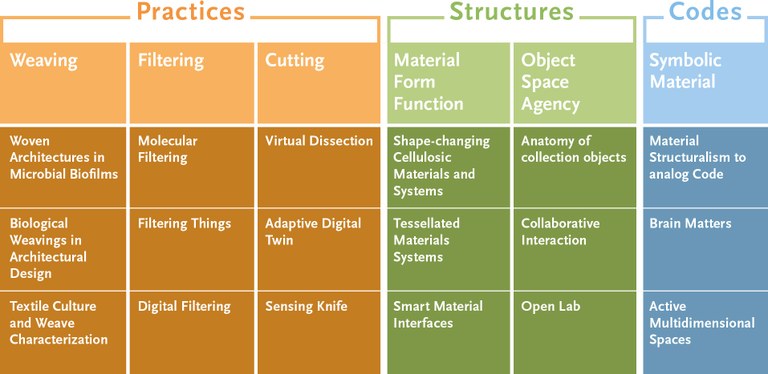Research Program

Research Unit Practices
Practices serves our fundamental strategic purpose of unifying theory and practice. Our goal is to transform practices with a long cultural tradition into innovative processes, resulting in a fundamental change in our culture. Combining material processes and cultural practices is an essential research strategy for Matters of Activity enabling a highly concrete and “tangible,” but also epistemological and experimental analysis of the activity of images, spaces, and materials. We conceive weaving as a practice central to nearly all biological materials and as such highly relevant to the analysis of the material’s inner activity. Woven tissues are closely linked to filtering, which we will also study as a vitally important process in nature and culture. As a condition of possibility for the production of difference, we combine the analysis of molecular material filters and digital information filters. Cutting will be investigated as a third material and equally fundamental subtractive practice of form-building: We have selected surgery and anatomy as two critical classic cutting scenarios in which we envision bodily material tissue as a foundation for novel ways of smart material-guided cutting. Since these practices are of equal importance in nature and culture for the production of images, spaces, and materials, we will seek to harness natural processes as inspiration for the design of innovative practices.
Projects: Weaving | Filtering | Cutting
Research Unit Structures
An essential second layer in our research (research unit Structures) will be the active structures generated through the material’s practices and activities. As we regard natural materials as an enormous repository of challenging geometric structures with unknown functions, a central goal here is to reveal the intrinsic relationship between the material’s form and functional dimensions. It is the inner structure of the material that enables shape-changing or an intrinsic combination of stiff and flexible elements in tessellated structures. It is equally important to analyze the consequences of active structures and materials on the quotidian level of objects, individuals, and architectural spaces. This approach will enable us to analyze how our own research activities will be transformed by recognizing the activity of materials, images, objects, and even buildings.
Projects: Material Form Function | Object Space Agency
Research Unit Codes
The research unit Codes addresses the methodological challenge of developing the idea of material code. Our focus on material practices is the merging of the symbolic and physical dimensions. We no longer conceive the material’s inner activity as dysfunctional failures, but positively as an essential operative coded structure and a re-invention of the analog. Our approach is similar to the emergence of the concept of genetic code in the 1950s, when biologists and information scientists started to consider genetic molecules as symbolic code. We propose to extend the idea of coded material from genes to the whole sphere of biological material and hence to matter as such. This fusion of code and matter goes beyond the conventional idea of alphanumeric linear code and addresses the intrinsic relationship between image, matter, and space. As an additional degree of freedom, the materialized symbolic dimension enables us to describe active materials as coded hardware.
Project: Symbolic Material
Impact
Reconfiguring active materiality will not only change our relationship with nature, culture, and technology, but also our design processes and their execution: Materials will no longer need to be adapted to industrial designs; instead, design will adapt to the activity of materials, paving the way for more sustainable and energy-sufficient devices and artifacts. Our intention is to describe, foster, and catalyze this revolution. We also expect to establish analog coding as a new integrative field of research of equal importance to the humanities, sciences, and engineering. An innovative dimension of our research is its fundamentally public character as it will be conducted in direct contact with the public, e.g. through innovative exhibitions and interaction formats in the Humboldt Labor in the Humboldt Forum, opening in 2019. Conceived as an Open Lab, Matters of Activity will thus enable a novel kind of impact that highlights not only the outputs and results of our research, but also the research process as such. The intensive cooperation with a wide range of national and international research institutions, start-ups, and cultural organizations will also foster a long-term dialog between the research conducted in the Cluster and society at large.
